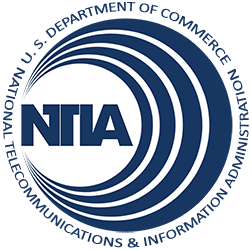Much of the Eastern Sierras region between Carson City, Nevada and Barstow, California is dependent on decades-old telephone infrastructure and has limited, insufficient broadband middle mile capabilities, leaving wide swaths of the Central Valley and eastern California unserved. The California Broadband Cooperative’s Digital 395 Middle Mile project proposes to build a new 553-mile, 10 Gbps middle-mile fiber network that would mainly follow U.S. Route 395 between southern and northern California. In addition to 36 municipalities, the project’s proposed service area encompasses six Indian reservations and two military bases. More than 230 community anchor institutions would be directly connected at speeds of 10 Mbps, with 2.5 Gbps and higher-capacity fiber-based services offered to the region’s last mile providers to expand or enhance service to households and businesses.
Nevada

| Grantee | Total Award | Type |
|---|---|---|
| California Broadband Cooperative, Inc. | $81,148,788 | Infrastructure |
| Communication Service for the Deaf, Inc. | $14,988,657 | Sustainable Adoption |
| Connected Nation (Nevada) | $3,993,441 | Broadband Data & Development |
| Las Vegas-Clark County Urban League | $4,680,963 | Public Computer Centers |
| Lyon County School District | $745,005 | Public Computer Centers |
| Nevada Department of Cultural Affairs | $806,045 | Public Computer Centers |
| Nevada Hospital Association | $19,643,717 | Infrastructure |
| One Economy Corporation | $28,519,482 | Sustainable Adoption |
| Pyramid Lake Paiute Tribe | $7,070,006 | Infrastructure |
| University Corporation for Advanced Internet Development | $62,540,162 | Infrastructure |
Broadband’s ability to expand educational and employment opportunities is especially meaningful for Americans who are deaf or hard of hearing, a community that faces unique challenges in education and that suffers from a rate of unemployment much higher than the national average. Communication Service for the Deaf, Inc. (CSD) intends to expand broadband adoption among people who are deaf and hard of hearing and provide them with online tools to more fully participate in the digital economy. The project proposes to employ a combination of discounted broadband service and specialized computers, technology training from an online state-of-the art support center customized to the community’s needs, public access to videophones at anchor institutions from coast to coast, and a nationwide outreach initiative. Thousands will gain online access to all the Internet has to offer, including sign language interpreters, captioned video services, and other content and functionalities designed especially to advance their educational, employment, and healthcare interests.
Project Components
State Broadband Capacity Building:
Staff time for this project will support the Nevada Broadband Task Force and, at the direction of the Task Force and the State Librarian, coordinate statewide broadband activities and provide outreach to local communities.
Technical Assistance:
Through this project, the Connect Nevada initiative will gather and present research to local communities, government and non-profit offices and agencies. In combination with survey work funded in the original proposal, Connect Nevada will have the tools to provide the Task Force with an analysis of how well the state has met the goals it presented in its broadband strategic plan.
Local Regional Technology Planning Teams:
This project will support regional planning teams in the 14 counties with the lowest rates of broadband availability and adoption. Planning Teams will meet at local libraries and will be composed of volunteers representing a cross-section of the community. The local planning process will work in parallel with and compliment the work of the BTOP-funded “One Click Away” project, which will provide technical training to local residents.
Data Collection, Integration, and Validation:
This project was originally funded for broadband planning activities and two years of data collection. In September of 2010, this project was amended to extend data collection activities for an additional three years and to identify and implement best practices.
The Access to Computer Technology and Instruction in Online Networking (ACTION) project plans to expand the capacity of 14 public computer centers and create 15 new computer centers in public housing developments and community and senior centers throughout the most economically disadvantaged communities in Clark County, Nevada. The 29 centers will offer computer classes, job training and certification programs, and community health programs through local partner organizations. Overall, the project expects to replace about 100 workstations and add more than 90 new ones, enabling the centers to increase the number of users served from approximately 1,600 to 4,600 per week. The 29 public computer centers will be located to serve vulnerable populations in public housing developments, low-income and high unemployment communities, and senior centers.
Unemployment in Lyon County, Nevada is well above the national average and many residents rely on public computer centers for access to job information and education, greatly increasing the demand for these critical public facilities. The Lyon County School District plans to help improve economic opportunities for residents of Lyon and neighboring Mineral County through its Computer Centers for Rural Nevada project. In addition to creating public computer centers, the project proposes to provide instructors and volunteer trainers for basic computer literacy, GED preparation, and ESL training, while local schools plan to offer college credit and advanced placement classes to high school students and community members. Several local small businesses have also committed to use the centers to train local residents in specialized skills pertinent to their industries. The Walker River Paiute Tribe and Yerington Paiute Tribe plan to utilize the public computer centers to view or participate in national tribal events.
Nevada has seen a 45 percent increase in public library computer usage in the past two years for job searches and other training opportunities. To meet this growing demand, the Nevada Department of Cultural Affairs proposes to expand the training and educational capacity at libraries and other hubs for free computer access in each of 15 counties throughout the state. The Nevada One Click Away project plans to upgrade 34 public computer centers and create one new center. The project also proposes to enhance existing computer training programs, including computer skills training provided by librarians and volunteers, and adding accessible technology and computer classes in Spanish in the larger participating library branches. Additionally, some libraries plan to partner with the local Chambers of Commerce to host small business workshops focused on best practices, customer creation and retention, and marketing practices.
The Nevada Hospital Association proposes to build and operate a statewide telemedicine network to be made available to 37 medical providers throughout the state, with additional capacity for use by public safety agencies,
educational institutions, tribal governments, and last-mile Internet service providers. The Nevada Broadband Telemedicine Initiative aims to construct 224 new miles of fiber network while utilizing an additional 453 miles of
existing fiber and 580 microwave miles to connect the rural hospitals at speeds between 100 Mbps and 1 Gbps.
The 21st Century Information and Support Ecosystem project proposes to implement a comprehensive program of computer training, wireless Internet access, broadband awareness marketing, and online content and applications to residents of 159 affordable and public housing developments and low-income communities in 50 cities and towns across 31 states and the District of Columbia. The project plans to implement four principal programs: training 2,500 youth to become “Digital Connectors” who will then provide digital literacy training to others in their communities; deploying localized broadband networks in public housing developments; developing online content and applications aimed at low-income, low-literacy audiences.
To address low Internet speeds and a general lack of access to online tools like distance learning, telemedicine, and enhanced public safety services on its reservation, the Pyramid Lake Paiute Tribe proposes a public-private partnership project to deploy a fiber-optic middle mile network across 742 square mile reservation. The project, Natukwena Nagwesenoo—a Paiute phrase which means “to weave information”—proposes the construction of 44 new miles of fiber in partnership with Praxis Associates that will provide direct connections to local community anchor institutions at a minimum speed of 10 Mbps. The connected organizations are expected to include the regional health service center, the Wadsworth grade school, the regional youth treatment center, and the only adult higher education center on reservation lands.
As part of a longstanding project to connect essential community anchor institutions across the country, and facilitate closer collaboration and long-term benefits for education, research, healthcare, public safety, and government services, the University Corporation for Advanced Internet Development (UCAID) proposes a comprehensive 50-state network benefitting approximately 121,000 community anchors. The project proposes a large-scale, public-private partnership to interconnect more than 30 existing research and education networks, creating a dedicated 100-200 Gbps nationwide fiber backbone with 3.2 terabits per second (TBps) total capacity that would enable advanced networking features such as IPv6 and video multicasting. The project plans to connect community anchors across all disciplines into virtual communities with shared goals and objectives, including colleges, universities, libraries, major veterans and other health care facilities, and public safety entities, with additional benefits to tribes, vulnerable populations, and government entities.
